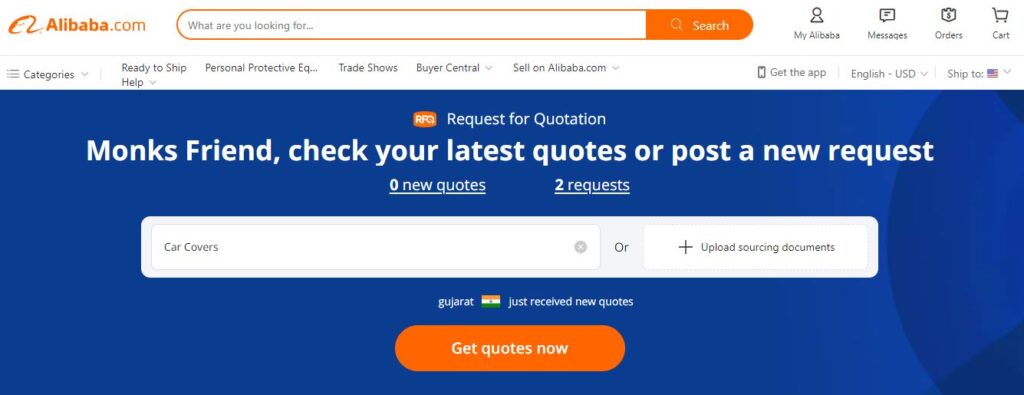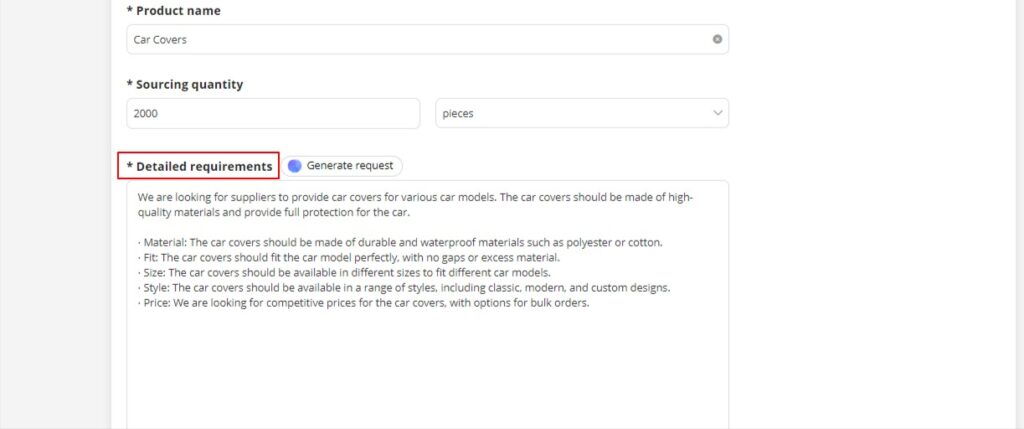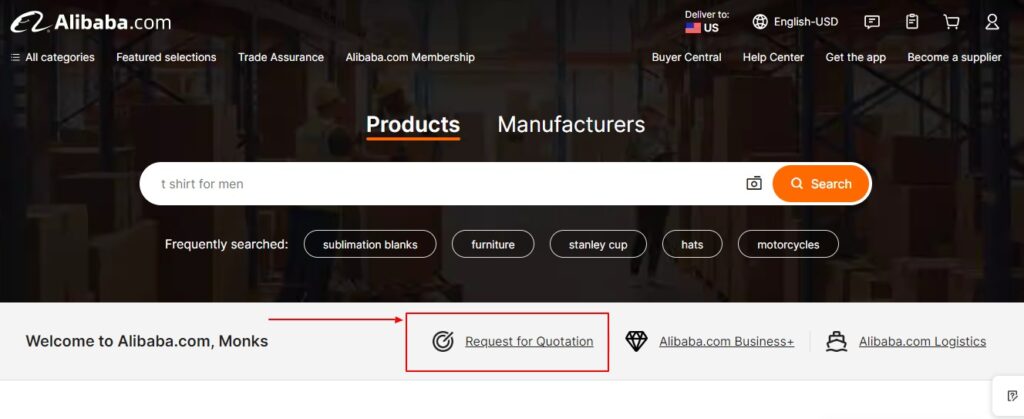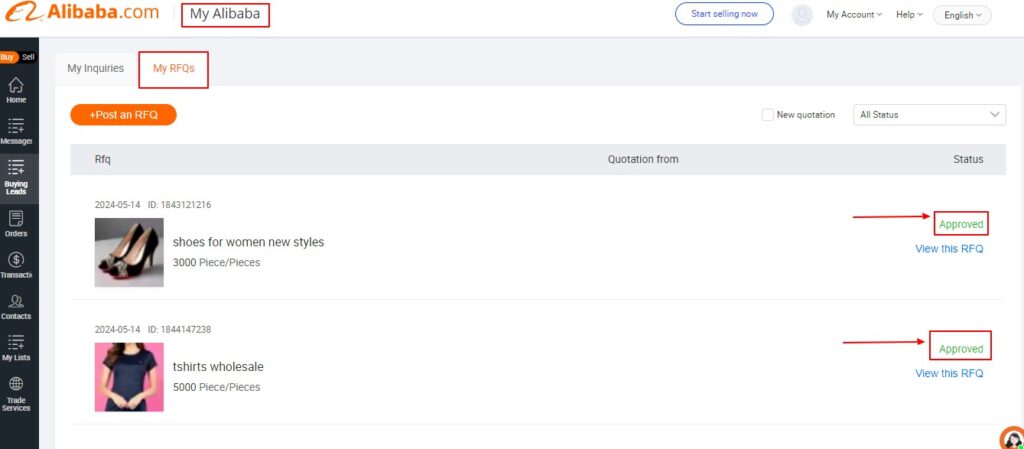Estimated reading time: 8 minutes
How do businesses find all sorts of fantastic marketable products to sell online? It all starts with connecting with suppliers around the world. One marketplace that houses these possibilities is Alibaba.
This platform allows buyers to create and send quotation requests. An Alibaba RFQ starts the conversation between you and potential suppliers.
It is like sending a message to many suppliers at once. You tell them what you’re looking for, like phone cases, how many, and how soon. The suppliers will send you their best prices to compete for your business.
A good RFQ is essential to finding the best product price to match the perfect product. We will share tips on creating an effective Alibaba RFQ. We will also cover ways to make it easy for suppliers to understand your needs.
To find reliable suppliers in Alibaba, start by screening the supplier’s profile through Alibaba’s RFQ system. Then filter them to show only those displaying the “Trade Assurance” badge, meaning this is a more credible, buyer-protected supplier. Check if the status of the supplier’s company is legit.
While checking the responses to your RFQ, carefully check some important aspects of a potential supplier: their production capability, quality control processes, and payment terms.
Further, confirm the reliability of a supplier by personally contacting them for specific inquiries and documentation that can serve as supporting documents.
Order samples of the product whenever possible, before ordering in bulk. Doing so minimizes risks and further facilitates a better sourcing experience.
Zack – Owlsourcing
Alibaba RFQ – What Is It?

An Alibaba RFQ is like sending a formal email to suppliers. It stands for Request for Quotation. It is a formal document used by Alibaba to request price quotes from potential suppliers.
Think of it like a standardized inquiry you send to many vendors on Alibaba. This is how it works:
The RFQ outlines your specific requirements. It includes the exact product you want. Also, it contains the quantity you need and any other details required. These specifics include color, size, and material.
Once Alibaba approves the RFQ, suppliers receive it. Alibaba’s search algorithms can help in this regard. They target vendors who have a history of supplying similar products.
Suppliers interested in fulfilling your order will respond to your RFQ. They will respond with their best price offer. It allows you to compare pricing and other terms from many vendors. Thus, it ensures you get the best deal.
RFQs are a pretty handy tool when you want to compare the prices of various suppliers to find the lowest price possible.
Source: Alibaba
Why Does Alibaba RFQ Matter?
An Alibaba RFQ is not just for quotes. It is a crucial business tool on this crowded platform, especially for your business.
It helps you streamline communication and ensure precise requirements. Moreover, it also enables you to get competitive pricing and gain negotiation power. Ultimately, it saves time.
1) Clear Communication
You must know how to contact Chinese manufacturers to start a conversation. Alibaba RFQs remove this need. They show your requirements in a clear format. Suppliers can readily grasp your needs, allowing faster and more focused communication.
2) Getting What You Want
An Alibaba RFQ is a detailed blueprint for meeting your product sourcing needs. You can mention the exact product you need. It includes precise details like materials, dimensions, and functions.
This detailed communication reduces the risk of misinterpretations. It ensures suppliers quote what you need precisely.
3) Finding the Best Deal
Comparing quotes side-by-side lets you find the cheapest option. It maximizes your chances to find the best offers on quality products.
4) Making Negotiations
We have already shared tips for negotiating with Chinese suppliers. Having multiple quotes gives you power in negotiations.
It lets you negotiate with more confidence. You have a range of pricing options. You can use them to get better deals from your preferred suppliers.
5) Saving Time
Alibaba RFQs are a significant time-saver. You cannot browse the platform’s vast network in one attempt. It saves you many hours of research and contacting suppliers. You can reach many vendors by sending out a single RFQ.
What Are the Essential Components of Alibaba RFQ?
A good Alibaba RFQ hinges on including crucial parts. It must clearly state your needs and attract qualified suppliers. Here are some tips for crafting a compelling Alibaba RFQ.
1) Detailed Product Description

Specificity is key. State the exact product you want with precise details. You can include the product’s name, model number, and brand. Also, include its function and any other needed variations.
You can outline any relevant technical specifications. It might include dimensions, weight, materials, color options, and functions. These are crucial technical aspects of the product.
You can also attach existing images or product samples to your RFQ. It provides a visual reference for suppliers. Besides, it ensures they quote on the exact product you need.
2) Quantity Requirements
Clearly state the exact quantity you need. It is helpful when you have a specific production target. It helps target suppliers who can realistically fulfil your order size. You should prefer RFQ even if you know how to find low MOQ Alibaba suppliers.
3) Target Price Range (Optional)
While not mandatory, including a target price range can be beneficial. It gives suppliers an idea of your budget. It helps them tailor their quotes. Besides, it also helps weed out unrealistic offers that are too far outside your budget.
4) Delivery Timeline
Specify your desired delivery timeframe. This helps suppliers understand your urgency. It lets them suggest realistic delivery schedules.
5) Payment Terms
Outline your preferred payment terms. It could be an upfront payment, a letter of credit, or other options. Specifying preferred terms helps suppliers understand your payment plans.
6) Clear Call to Action
Finish your RFQ with a clear call to action. It could invite suppliers to submit their best quotes by a specific deadline. You can also include contact information for any further inquiries.
Note:
- Proofread your RFQ carefully before submitting it. Typos or errors can form a negative impression on potential suppliers.
- Consider using Alibaba’s pre-built RFQ template as a starting point. This template can help ensure you capture all the essential information.
- Including these critical parts will make your Alibaba RFQ clear and informative. It will attract suppliers who can meet your needs.
How do you send an RFQ on Alibaba (Alibaba RFQ Example)?

Here’s a more descriptive breakdown of sending Alibaba RFQs.
1) Access the RFQ Section
After signing in to your Alibaba account, click ‘Request for Quotation.’ You can do this under the buying tab or in the RFQ section. Look for a button like “Create RFQ” or “Post RFQ.”
You can choose between a quick RFQ or a detailed RFQ. Select “Detailed RFQ” to gain the most control over your request.
2) Craft Your Product Description
Be as specific as possible! Include the product name and model number (if applicable). Add a detailed description. It should cover the materials, dimensions, functions, and critical details.
Consider uploading high-quality images or samples of the desired product for visual reference. Now, Alibaba has included an AI RFQ generator that gives your plans better wording.
3) Specify Your Requirements
Clearly state the quantity you need. Include your minimum order quantity (MOQ) if you’ve already set one. It will target suppliers who can fulfil your order size.
4) Mention Price and Timeline
Including a target price range can be helpful. It gives suppliers an idea of your budget and allows them to tailor their quotes. You can also specify the desired delivery timeframe.
5) Finish an RFQ and Submit
Indicate your preferred payment method (e.g., upfront payment, letter of credit). You can set a clear deadline for suppliers to submit their quotes. When you’ve proofread everything, submit your RFQ and wait for responses.

After submitting, Alibaba will approve or reject your RFQ. You can see it in ‘My Alibaba’ under the ‘My RFQ’ tab. Depending on your product and needs, quotes may arrive within hours or days. Compare them and choose carefully.
Sample of Alibaba RFQ Template
I’ve mentioned this before, but responding with a properly written-out RFQ (Request for Quotation) will have you get a handful of supplier responses in a few minutes.
But watch out: most suppliers on a sourcing platform will only be able to respond with a maximum of 20 free RFQs a month. If they have to respond with more, it will cost them, so it usually means top suppliers only focus on the professional and well-planned RFQs.
That’s why it’s so important to create a clear, detailed RFQ, it increases the chances that you’ll receive quality answers from dedicated manufacturers.
As a seasoned China sourcing agent, we’ve created an effective RFQ template that consistently gets responses from top suppliers.
Below, we’ll outline what your RFQ should include and provide an example you can tailor to suit your product needs.
What Should an Effective RFQ Include?
RFQ documents vary depending on the industry, but a good one typically includes:
1. Buyer Information
- Project title or product procurement goal
- Business background (i.e., Amazon seller, eCommerce brand)
- Contact information
- Clear instructions to provide a quote
- Key dates (e.g., response due date)
2. Product Specifications
- Detailed product descriptions and features
- Size, color, material, packaging, etc.
- Target quantity and order size
- Delivery or lead time requirements
- A pricing plan or table to fill out
3. Evaluation Criteria
- Any minimum supplier requirements
- Type of RFQ (open to all or closed to invited suppliers)
- Timeline and process of making decisions
- Things you’ll use to choose the winning quote
4. Terms and Conditions
- Compliance with law or safety
- Documentation required
- Any certification required (e.g., CE, FDA)
- Terms of payment, shipping preferences, and standard contracts
Sample RFQ Template You Can Use
Here’s a good RFQ sample that suppliers are more likely to respond to:
Hi
My name is Sarah, and I own a U.S.-based DTC (direct-to-consumer) skincare business. I am looking for a reliable source of customized cosmetic bags for an upcoming launch.
Product Details:
- Material: Waterproof PU Leather
- Colors: Black, Nude Pink, Sage Green
- Size: 20cm x 12cm x 8cm
- Features: Robust zipper, internal mesh pocket, wipe-friendly lining
- Logo: Embossed logo on front panel
- Packaging: Custom-printed kraft boxes (please advise available packaging)
Order Details:
- Sample Order: 1,000–2,000 units
- Mixed colors are desirable
- In case quality is as desired, repeat business will be received in bulk volumes
Shipping: Quote both EXW and CIF to:
Los Angeles, CA 90021, USA
Kindly advise whether you can arrange sea freight directly or not, or else I have to use my freight forwarder.
Looking forward to your quote along with product photos, MOQ, lead time, and sample availability.
Thank you!
— Sarah
✨ Final Tip: The More Details, The Better
Even if you still have your idea for your product in the works, make your RFQ as thorough as possible. A lackadaisical request will yield low-effort or no replies.
The well-written RFQ means you are only getting qualified suppliers replying and not those who simply do not understand.
Need assistance writing your next RFQ? We’re here to guide you through it—just give us a shout anytime.
Step-by-step Alibaba Buyer RFQ process
1. Buyers access Alibaba RFQ through the main page of RFQ.
Buyers start to initiate the RFQ on Alibaba.
2. Buyer fulfils the RFQ form
They have to fill in some details about the product specifications, quantity, or any other requirements.
3. Buyers click “Submit RFQ”.
The request is submitted officially for the response from suppliers.
4. Buyers post the request for a quotation
RFQ is published now and can be viewed and bid upon by suppliers.
5. RFQ is checked & approved by Alibaba industry expert
Alibaba checks that the RFQ follows the guidelines and that it is clear to the suppliers.
6. Buyers receive and review quotations
Suppliers give their offers; buyers will review the prices against terms and conditions.
7. Buyers shortlist the suppliers to proceed further
They decide whether or not to proceed with some suppliers and continue the search.
- If they are satisfied with 2-3 suppliers
They contact the shortlisted suppliers for samples to check the quality.
- If no supplier meets their requirement
They can start another round of RFQ or directly inquire of suppliers on Alibaba.
Dos and Don’ts for Creating an Effective RFQ!
When crafting a good Alibaba RFQ, how do you know what to avoid or emphasize? We’ve made it more accessible.
| Dos | Don’ts | Reason | Tip |
| Proofread your RFQ carefully | Submit an RFQ with typos or grammatical errors | Errors create a negative impression on suppliers. | Double-check spelling and grammar before sending. |
Consider using Alibaba’s pre-built RFQ template |
Write your RFQ from scratch without a template | Saves time and ensures you capture essential information. | Start with the template and customize it for your needs. |
Attach images or samples (if available) |
Rely solely on text descriptions |
Provides a clear visual reference for suppliers. |
Include high-quality photos or product samples if you have them. |
Set a clear deadline for quote submissions |
Leave the deadline open-ended | Encourages suppliers to respond promptly. | Set a reasonable deadline based on your urgency. |
As mentioned earlier, to find genuine suppliers using Alibaba RFQ, it is essential to carefully review supplier profiles. Here is my recommendation for this step:
Key Factors to Review in an Alibaba Vendor Profile
| Criteria | Details to Consider | Importance |
|---|---|---|
| Company Type | Distinguish between factories and trading companies. Factories usually offer better control over production, while trading companies provide a broader product range. | Affects order reliability and product sourcing flexibility. |
| Location | Check the supplier’s location to evaluate logistics and transportation costs. | Impacts shipping time and costs. |
| Verified Supplier Status | Indicates third-party verification confirming legitimacy. Verified Suppliers actively promote their brand and invest in their reputation. | Ensures you’re dealing with a trusted partner. |
| Rating | A rating of 4.5 or higher is a good benchmark for reliability and service quality. | Reflects overall customer satisfaction. |
| Years on Platform | Longer tenure on Alibaba often correlates with reliability and experience. | Suggest established and trustworthy operations. |
| Workforce Size | Larger workforces indicate the ability to handle bulk orders efficiently. | Ensures scalability for larger projects. |
| Minimum Order Quantity (MOQ) | Verify the MOQ aligns with your order requirements. | Affects the feasibility of working with the supplier. |
| On-Time Delivery Rate | Represents the percentage of orders delivered on time in the past 180 days. | High rates indicate dependable order fulfillment. |
| Export Revenue | Higher export revenue reflects strong global competitiveness and reliability. | Demonstrates proven success in international trade. |
| Production Area | Larger facilities often suggest greater manufacturing capacity and scalability. | Critical for high-volume orders. |
| Customer Reviews | Provides real feedback on product quality and supplier performance. | Offers insights from previous buyers’ experiences. |
| Contact Information | Ensure up-to-date phone numbers and email addresses for direct communication. | Facilitates smooth communication. |
| Official Website | A professional website provides more comprehensive information about the supplier. | Helps in verifying legitimacy and learning about the company. |
To find genuine suppliers using Alibaba RFQ, we also have another tool: the “Verified Supplier” status on Alibaba. Here is my recommendation for this step:
What Does the “Verified Supplier” Status on Alibaba Indicate?
The “Verified Supplier” status on Alibaba represents the credibility and commitment to a supplier’s quality.
This status is granted after the supplier undergoes stringent verification through independent auditing firms like SGS, Intertek, or TÜV.
Suppliers with this status meet strict standards for reliability, manufacturing practices, and compliance.
Key Features of the Verified Supplier Program
| Feature | Details | Importance |
|---|---|---|
| Verification Process | Suppliers provide documentation (licenses, certifications) and undergo an audit by a third-party inspection company. Audits include facility visits, quality checks, and compliance assessments. | Ensures legitimacy and operational integrity. |
| Audit Outcome | Suppliers receive a detailed audit report and video, which are accessible to buyers for added transparency. | Offers insight into supplier operations and product quality. |
| Identification | Verified Suppliers are marked with a blue “Verified” badge next to their company name in search results and on profile pages. | Helps buyers quickly identify trusted suppliers. |
| Paid Membership | Suppliers must invest in this program, demonstrating their commitment to quality and trustworthiness. | Highlights the supplier’s seriousness about global trade. |
Types of Verified Suppliers
Alibaba has categorized Verified Suppliers into three distinct groups based on their services:
| Type | Description | Best For |
|---|---|---|
| Custom Manufacturers | Specializes in producing goods based on custom orders. Ideal for buyers seeking exclusive, tailored products that stand out in the market. | Businesses require unique, custom-made products. |
| General Suppliers | Offer a broad range of products and services across multiple industries. Their scale often results in competitive pricing and diverse offerings. | Buyers with varied needs or looking for cost-effective solutions. |
| Brand Owners | These suppliers produce and sell goods under their own brands. Their products are typically high quality and ready for resale. | Entrepreneurs seek branded goods to sell without developing their own products. |
By selecting Verified Suppliers, buyers gain greater confidence in their sourcing decisions, benefiting from higher transparency, reliable operations, and reduced risk.
Read More:
Final Thoughts!
You can attract qualified suppliers with clear communication just by sending one RFQ. It will help you score the best deals on your desired products.
Remember, taking time to craft a clear RFQ upfront is an investment. It saves you time and resources later. Now, go there and start sourcing like a pro!
However, RFQs don’t guarantee securing reliable partners. You may face challenges in identifying suitable suppliers and ensuring quality standards. A proficient China sourcing service can help you mitigate these risks.
An agent can offer their expertise, industry connections, and on-the-ground presence.



4 thoughts on “How to Efficiently Use Alibaba RFQ to Find the Best Suppliers?”
Wow, thank you Andy for this special article on determining if an Alibaba supplier is fake! So for anyone who wants to share their experiences in sourcing from Alibaba, let me just tell you that one must always be keen when selecting a supplier. The guidelines listed in this article are detailed and effective: They offer useful recommendations and solutions for selecting suppliers that can be deemed reliable and credible. Thank you for such groundbreaking information enabling buyers to manage their purchases from Alibaba wisely.
Thank you for your thoughtful comment, Ammos! I’m glad you found the article on identifying fake Alibaba suppliers helpful. Sharing experiences and following detailed guidelines can indeed make a significant difference in selecting reliable and credible suppliers. Your emphasis on keen selection is spot on, and I appreciate your feedback. If you have any further questions or need more insights, feel free to reach out. Happy sourcing!
What are some red flags to watch out for when evaluating suppliers on Alibaba that you think are crucial for beginners to know?
Thank you for your question! When evaluating suppliers on Alibaba, here are some red flags to watch out for:
1. Incomplete profiles with minimal company information. 2. Unverified status or low ratings. 3. Lack of third-party certifications and compliance. 4. Poor communication or slow responses. 5. Offers that seem too good to be true, indicating possible scams.
If you need more detailed assistance, feel free to contact us anytime!